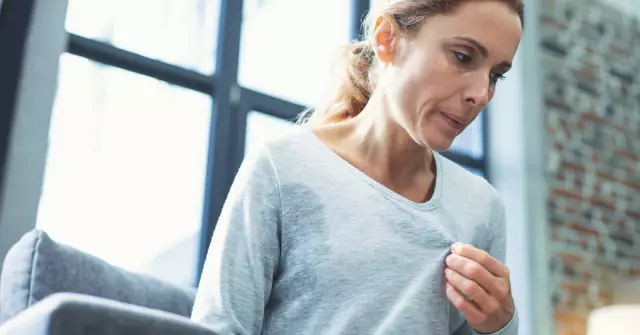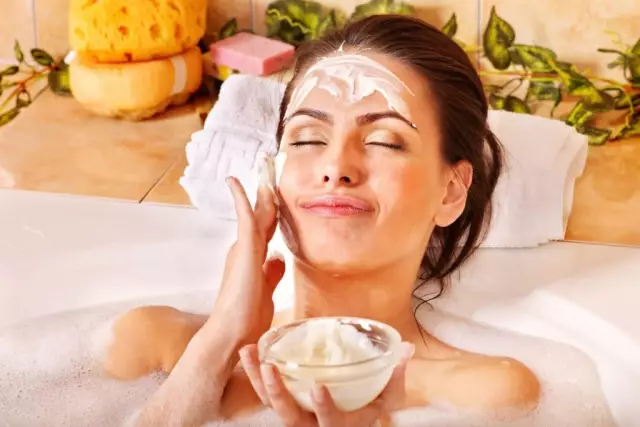- Author Rachel Wainwright [email protected].
- Public 2023-12-15 07:39.
- Last modified 2025-11-02 20:14.
Exostat
Exostat: instructions for use and reviews
- 1. Release form and composition
- 2. Pharmacological properties
- 3. Indications for use
- 4. Contraindications
- 5. Method of application and dosage
- 6. Side effects
- 7. Overdose
- 8. Special instructions
- 9. Application during pregnancy and lactation
- 10. Use in childhood
- 11. Drug interactions
- 12. Analogs
- 13. Terms and conditions of storage
- 14. Terms of dispensing from pharmacies
- 15. Reviews
- 16. Price in pharmacies
Latin name: Exostat
ATX code: D01AE22
Active ingredient: naftifine (naftifine)
Manufacturer: VERTEX, CJSC (Russia)
Description and photo update: 2018-27-11

Exostat is an antifungal drug (antimycotic) for external use.
Release form and composition
- solution for external use: transparent, pale yellow or colorless, with the smell of ethanol (10, 15 or 20 ml in a dark glass bottle, sealed with a polyethylene dropper stopper and a screw cap with first opening control, 1 bottle in a cardboard box);
- cream for external use: slightly granular or homogeneous, shiny, almost white or white, with a weak characteristic odor (15 or 30 g in an aluminum tube, 1 tube in a cardboard box).
Each pack also contains instructions for the use of Exostat.
Composition of 1 ml solution:
- active substance: naftifine hydrochloride - 10 mg;
- additional components: ethanol 95% (ethyl alcohol 95%), propylene glycol, purified water.
Composition of 1 g of cream:
- active substance: naftifine hydrochloride - 10 mg;
- additional components: polysorbate 60, isopropyl myristate, stearyl alcohol, sorbitan stearate (sorbitan monostearate), cetyl alcohol, cetyl palmitate, sodium hydroxide, benzyl alcohol, purified water.
Pharmacological properties
Pharmacodynamics
Naftifine is an antifungal agent for external use from the class of allylamines. The effect of the drug is due to the suppression of squalene-2,3-epoxidase, which results in a decrease in the production of ergosterol, a component of the fungal cell membrane.
The active substance is active against dermatophytes (including Microsporum, Epidermophyton, Trichophyton), yeasts (Pityrosporum, Candida spp.), Molds (Aspergillus spp.) And other types of fungi (including Sporothrix schenckii).
In relation to aspergillus and dermatophytes, naftifine exhibits a fungicidal effect, and in relation to yeasts, depending on the strain of the microorganism, it can exhibit both fungicidal and fungistatic activity. The exostat is also characterized by antibacterial action against gram-positive and gram-negative microorganisms, which can lead to the development of secondary bacterial infections. Possessing an anti-inflammatory effect, antimycotic helps to quickly relieve symptoms of inflammation, especially itching.
Pharmacokinetics
When used externally, the Exostat solution and cream, naftifine is well absorbed by the skin, ensuring the creation of stable antifungal concentrations in its various layers. After the procedure, less than 6% of naftifine undergoes systemic absorption. Part of the absorbed dose after metabolic transformation is excreted by the kidneys and through the intestines. The half-life of the active substance is 2-3 days.
Indications for use
- interdigital mycoses (tinea pedum, tinea manum);
- fungal infections of the skin and skin folds (tinea corporis, tinea inguinalis);
- fungal infections of the nails (onychomycosis);
- dermatomycosis, which are accompanied or not accompanied by itching;
- multicolored (pityriasis) versicolor;
- candidiasis of the skin.
Contraindications
- treatment of the wound surface (for solution);
- During pregnancy and breastfeeding;
- hypersensitivity to any of the components of Exostat.
It is necessary to use this antimycotic in children with caution.
Exostat, instructions for use: method and dosage
Exostat cream and solution are used externally.
Recommended dosage regimen:
- skin lesions: the drug should be applied once a day to previously thoroughly cleaned and dried affected skin areas and adjacent healthy areas (approximately 1 cm of healthy skin is treated at the edges of the affected area); the course of treatment for dermatomycosis can be 2-4 weeks (the maximum duration of therapy is 8 weeks), for candidiasis - 4 weeks;
- nail damage: the drug should be applied 2 times a day to the affected nail; before the first procedure, it is required to remove the affected part of the nail with a nail file or scissors as much as possible; with onychomycosis, the course of therapy should not exceed 6 months.
To prevent relapse, the use of Exostat solution or cream must be continued for at least 2 weeks after the main clinical symptoms of the disease have disappeared.
Side effects
During therapy with Exostat, in rare cases, the following local reactions were noted: hyperemia (redness) or dry skin, burning sensation. These adverse reactions are reversible and do not require discontinuation of the drug. In case of aggravation of the severity of these effects or the appearance of any other disorders, it is necessary to urgently consult a doctor.
Overdose
There are no reports of drug overdose cases.
special instructions
Avoid getting the cream / solution in the eyes. The exostat is not intended for ophthalmic use.
In order to achieve a stable therapeutic effect, it is necessary to carry out a course treatment.
The solution demonstrates efficacy in the treatment of mycoses affecting areas of the skin with hyperkeratosis, as well as in areas of hair growth.
The propylene glycol contained in the solution is capable of provoking skin irritation. With the development of such disorders, treatment with the drug should be canceled and a specialist should be consulted.
Influence on the ability to drive vehicles and complex mechanisms
The drug does not adversely affect the ability to drive a car or other complex mechanisms.
Application during pregnancy and lactation
During pregnancy and lactation, it is contraindicated to be treated with the drug, since there are no data confirming the effectiveness and safety of its use during these periods.
Pediatric use
In children and adolescents, Exostat should be used with caution due to insufficient experience with the use of antimycotics in patients under 18 years of age.
Drug interactions
Interaction studies of naftifine with other drugs / agents have not been conducted.
Analogs
Exostat analogs are: Naftifin, Mikoderil, Mizol Evalar, Exoderil.
Terms and conditions of storage
Store out of the reach of children at a temperature not exceeding 25 ° C.
The shelf life is 3 years.
Terms of dispensing from pharmacies
Available without a prescription.
Reviews about Exostat
According to most reviews, Exostat is an effective drug that has been successfully used to treat fungal infections of the skin and nails. Many patients indicate that the drug not only eliminates the manifestations of fungal diseases in the form of redness, inflammation, itching, burning or other unpleasant sensations, but also eliminates the cause of these lesions and prevents their recurrence.
However, there are also reviews that note the ineffectiveness of Exostat in the treatment of advanced forms of fungal diseases, since in such cases an integrated approach to therapy is required. Some patients consider it a disadvantage of the product that it needs to be used for a long time to obtain the desired result.
Price for Exostat in pharmacies
The price for Exostat depends on the form of release and can be:
- solution for external use: 10 ml - 390-420 rubles, 15 ml - 495-570 rubles, 20 ml - 580-610 rubles;
- cream for external use: 15 g - 260-290 rubles, 30 g - 490-520 rubles.

Maria Kulkes Medical journalist About the author
Education: First Moscow State Medical University named after I. M. Sechenov, specialty "General Medicine".
Information about the drug is generalized, provided for informational purposes only and does not replace the official instructions. Self-medication is hazardous to health!






